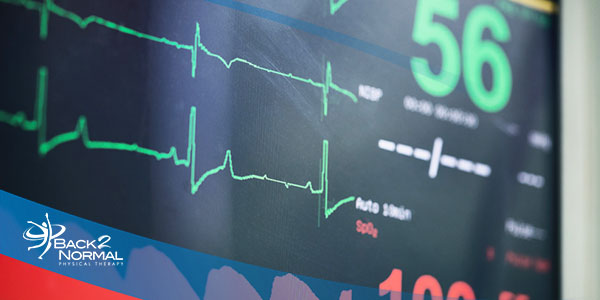
Heart rate variability (HRV) is a measure of the variation of time between your heartbeats. It’s a personalized metric that serves as one of the key indicators of your recovery status, overall health, and fitness level. It provides a snapshot analysis of your autonomic nervous system (ANS) functionality—directly relating to your body’s ability to turn on/off the fight or flight response. Your HRV can range anywhere from below 20 to over 200 milliseconds, and levels naturally fluctuate day-to-day. A key sign of health and recovery is a resilient HRV score that can rebound after taking a hit or gradually improve over time.
Heart Rate Variability (HRV) Diagnostics
Back 2 Normal has integrated heart rate variability (HRV) technology into our practice to assess a patient’s physical state. This non-invasive, 5-minute procedure paints a picture of the body’s wellness and recovery capacity by gaining feedback from the electrical activity of the heart. Through analysis of this critical information, we can develop individualized plans to improve health status and increase functional capacity during fitness activities. In addition to assessing wellness in the general population, HRV diagnostics have also been utilized to demonstrate positive outcomes of physical therapy interventions in patients recovering from injuries when re-scanned throughout the course of treatment.
Changes in HRV can be seen in many scenarios:
- Long-term stress: prolonged stress can cause HRV values to gradually drop, indicating that the body may need more recovery time.
- Impact of illness: Being sick can acutely drop HRV. If it remains low, even after symptoms disappear, it may be a sign that the body needs more time to normalize.
- Disrupted sleep: Jet lag or inconsistent sleep can put a strain on the body. Over time, this can impact the ANS and will be reflected in declining HRV.
- Overtraining: If you complete a hard workout, it can quickly lower HRV. In recovery, HRV will rebound. If HRV doesn’t return to baseline, training may be too hard or too often. The body may need more time to recover.
HRV and COVID 19/Illness Prediction
The emerging use of HRV data is in the field of illness prediction and monitoring the body’s state during an illness. Wearable technology from popular brands now allows individuals to assess their HRV throughout the day and correlate that data to overall recovery capabilities and susceptibility to “risks” such as illnesses and injuries. In fact, Apple recently released a study they performed at Mount Sinai on heart rate variability metrics and predictive capacity for COVID 19, with significant changes in HRV metrics seven days ahead of the individual experiencing symptoms. The researchers also found that seven to fourteen days after diagnosis with COVID-19, the HRV pattern began to normalize and was no longer statistically different from the patterns of those who were not infected. This indicates the importance of HRV as a key metric for overall health and wellness and gives the individual a real-time assessment of how their body is functioning aside from what they can see or feel.
There are several ways that assessing autonomic nervous system functioning can help you reach your goals:
- Learn the link between stress, sleep, pain, mood, and injury. HRV therapy helps you understand how your body responds to certain triggers. This might include learning relaxation exercises and breathing exercises to improve HRV.
- Identify overuse injuries before they happen. Overuse injuries often happen when the body is in an inflammatory state. Research shows that inflammation is tied to increased sympathetic nervous system functioning and lower HRV.
- Predict training response. Some research suggests that HRV is useful for tailoring treatments to patients. For example, people with high HRV may respond better to higher intensity training, whereas those with low HRV may do better with a high volume but low-intensity approach.
- Alcohol, a heavy meal before bed, or late exercise speeds up your metabolism and can keep your heart rate elevated throughout the night, which can affect your recovery and leave you feeling unrested the next day.
Heart Rate Variability (HRV) Assessment
This non-invasive, five-minute test uses EKG clips on your wrists to measure heart electrical activity. It can give us a snapshot of your biological age, stress response, and how healthy or charged their biological batteries are, making it widely accepted as the way to determine how healthy your nervous system is.
Most people with illnesses, diseases, injuries, or stress are stuck in a perpetual state of the “fight or flight” side of their autonomic nervous system. This affects healing, immune function, and sleep. With this information, your therapist can put together a plan to help reverse the unhealthy tendencies of your nervous system.
Ready to supercharge your nervous system with Heart Rate Variability assessment and monitoring? Seek advisement with our specialists, and let us guide you with the most effective practices for your unique needs! We offer a wellness-focused & supportive environment that can help you achieve your goals. Be sure to check our social media and blog updates for regular wellness inspiration, information, offers, and support.
The Back 2 Normal blog is an educational resource written by Back 2 Normal employees and professional associates. Back 2 Normal bloggers are professionals who abide by the code of ethics outlined by their respective professional associations. The content published in blog posts represents the opinion of the individual author based on their expertise and experience. The content provided in this blog is for informational purposes only, does not constitute medical advice and should not be relied on for making personal health decisions.






